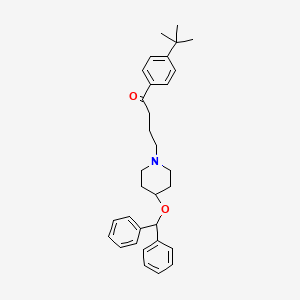Attribution Statement: LactMed is a registered trademark of the U.S. Department of Health and Human Services.
NCBI Bookshelf. A service of the National Library of Medicine, National Institutes of Health.
Drugs and Lactation Database (LactMed®) [Internet]. Bethesda (MD): National Institute of Child Health and Human Development; 2006-.
CASRN: 90729-43-4

Drug Levels and Effects
Summary of Use during Lactation
Ebastine is a nonsedating antihistamine that is not available in the United States, but is available in other countries. Preliminary evidence indicates that the amounts in milk are unlikely to affect a breastfed infant.
Drug Levels
Ebastine is a pro-drug that is metabolized to the active metabolite, carebastine, which has a much longer half-life than ebastine.
Maternal Levels. A woman with chronic urticaria was taking ebastine 10 mg daily during pregnancy and postpartum. On day 5 postpartum, the highest measured ebastine concentration in breastmilk was 6.3 mcg/L at 3.9 hours after the dose. The highest measured breastmilk carebastine concentration of 5.4 mcg/L occurred at 11.3 hours after administration. At 24.3 hours after the dose, the ebastine concentration was 1.1 mcg/L and the carebastine concentration was 4.4 mcg/L. Based on milk samples obtained at 11.3 hours after the dose, the authors estimated that a fully breastfed infant would receive daily dosages of 0.3 mcg/kg of ebastine and 0.2 mcg/kg of carebastine.[1]
Infant Levels. A woman with chronic urticaria was taking ebastine 10 mg daily during pregnancy and postpartum. At 24 hours after birth, her breastfed infant had an undetectable serum (<0.2 mcg/L) ebastine concentration and a carebastine concentration of 46.8 mcg/L, probably obtained via placental transfer. At 2 days postpartum, both ebastine and carebastine were undetectable in the infant’s serum.[1]
Effects in Breastfed Infants
A woman with chronic urticaria was taking ebastine 10 mg daily during pregnancy and postpartum. Her infant was exclusively breastfed until the age of 6 months. He showed normal development at 1 and 3 months of age.[1]
Effects on Lactation and Breastmilk
Antihistamines in relatively high doses given by injection can decrease basal serum prolactin in nonlactating women and in early postpartum women.[2,3] However, suckling-induced prolactin secretion is not affected by antihistamine pretreatment of postpartum mothers.[2] Whether lower oral doses of antihistamines or ebastine have the same effect on serum prolactin or whether the effects on prolactin have any consequences on breastfeeding success have not been studied. The prolactin level in a mother with established lactation may not affect her ability to breastfeed.
Alternate Drugs to Consider
References
- 1.
- Saito J, Yakuwa N, Sandaiji N, et al. Ebastine during pregnancy and lactation in a patient with chronic urticaria: Ebastine and carebastine levels in maternal serum, cord blood, breast milk, and the infant's serum. J Eur Acad Dermatol Venereol. 2020;34:e496–e7. [PubMed: 32249465]
- 2.
- Messinis IE, Souvatzoglou A, Fais N, et al. Histamine H1 receptor participation in the control of prolactin secretion in postpartum. J Endocrinol Invest. 1985;8:143–6. [PubMed: 3928731]
- 3.
- Pontiroli AE, De Castro e Silva E, Mazzoleni F, et al. The effect of histamine and H1 and H2 receptors on prolactin and luteinizing hormone release in humans: Sex differences and the role of stress. J Clin Endocrinol Metab. 1981;52:924–8. [PubMed: 7228996]
Substance Identification
Substance Name
Ebastine
CAS Registry Number
90729-43-4
Disclaimer: Information presented in this database is not meant as a substitute for professional judgment. You should consult your healthcare provider for breastfeeding advice related to your particular situation. The U.S. government does not warrant or assume any liability or responsibility for the accuracy or completeness of the information on this Site.
- User and Medical Advice Disclaimer
- Drugs and Lactation Database (LactMed) - Record Format
- LactMed - Database Creation and Peer Review Process
- Fact Sheet. Drugs and Lactation Database (LactMed)
- Drugs and Lactation Database (LactMed) - Glossary
- LactMed Selected References
- Drugs and Lactation Database (LactMed) - About Dietary Supplements
- Breastfeeding Links
- Absorption, distribution, metabolism and excretion of [14C]ebastine after a single administration in rats.[Arzneimittelforschung. 1994]Absorption, distribution, metabolism and excretion of [14C]ebastine after a single administration in rats.Fujii T, Matsumoto S, Amejima H, Hatoyama T, Nakao M, Kagemoto A, Tanaka K, Miyazaki H. Arzneimittelforschung. 1994 Apr; 44(4):527-38.
- Identification of rat faecal metabolites of ebastine by B/E linked scanning liquid secondary ion mass spectrometry.[Biol Mass Spectrom. 1994]Identification of rat faecal metabolites of ebastine by B/E linked scanning liquid secondary ion mass spectrometry.Yoshida K, Hatoyama T, Fujii T, Kagemoto A, Miyazaki H, Naruto S. Biol Mass Spectrom. 1994 Jul; 23(7):385-90.
- N-Dealkylation and hydroxylation of ebastine by human liver cytochrome P450.[Drug Metab Dispos. 1998]N-Dealkylation and hydroxylation of ebastine by human liver cytochrome P450.Hashizume T, Mise M, Terauchi Y, O L, Fujii T, Miyazaki H, Inaba T. Drug Metab Dispos. 1998 Jun; 26(6):566-71.
- Review Haloperidol.[Drugs and Lactation Database (...]Review Haloperidol.. Drugs and Lactation Database (LactMed®). 2006
- Review Dimenhydrinate.[Drugs and Lactation Database (...]Review Dimenhydrinate.. Drugs and Lactation Database (LactMed®). 2006
- Ebastine - Drugs and Lactation Database (LactMed®)Ebastine - Drugs and Lactation Database (LactMed®)
Your browsing activity is empty.
Activity recording is turned off.
See more...
